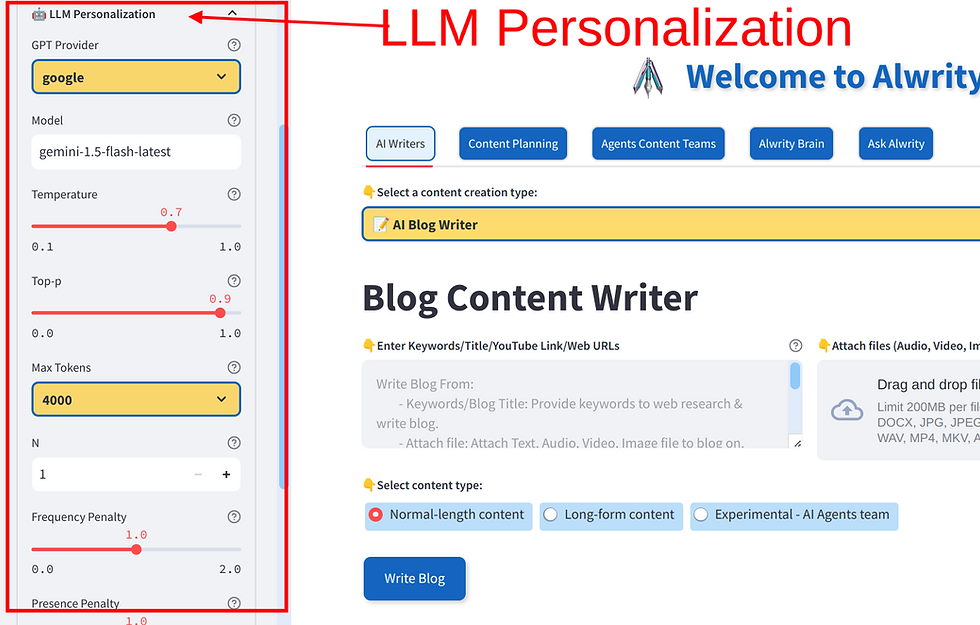AI Writing Innovations for Content Creation
- DikshaAI
- Apr 23, 2024
- 5 min read
Updated: Aug 19, 2024
With lightning-fast advancements in natural language Generation (NLG), the integration of large language models (LLMs), the rise of multimodal content creation, and the ethical considerations that accompany these innovations, AI writing is poised to revolutionize the way we craft and consume content. Let's dive in.
Table of contents:

1. Enhanced Natural Language Generation (NLG)
Natural Language Generation (NLG) is a specialized area of artificial intelligence (AI) that focuses on the automatic creation of human-like text by computers. Essentially, NLG systems convert structured data—such as numbers, facts, and figures—into coherent, contextually appropriate narratives that sound as if they were written by a human.
Impact on Content Creation
NLG has significantly transformed the content creation landscape. It enables machines to generate various types of content, including:
Reports
Summaries
Articles
Creative writing
With minimal human input, NLG can rapidly produce large volumes of content, which boosts productivity, scalability, and cost efficiency.
In addition to improving efficiency, NLG allows businesses to:
Personalize content for their audiences.
Automate repetitive writing tasks, such as product descriptions or weather reports.
Enhance decision-making by presenting data in a more engaging and understandable format.
A. Benefits of Improved NLG for AI Writing:
Enhanced Accuracy: NLG advancements ensure that AI-generated text is highly accurate, with minimal errors in grammar, spelling, and punctuation.
Improved Comprehension: AI writing tools can now comprehend complex topics and nuances, enabling them to produce content that is both informative and engaging.
Increased Personalization: NLG helps AI writing tools tailor content to specific audiences, considering factors such as demographics, interests, and writing style.

2. Integration of Large Language Models (LLMs)
LLMs, such as ChatGPT, Gemini, Claude, Ollama and BLOOM, are pushing the boundaries of AI writing. These models possess an unparalleled ability to generate high-quality, human-like content, making them indispensable tools for content creators. Giving them context like web research enhances their output content.
A. Impact of LLMs on AI Writing:
Generation of Human-like Content: LLMs can produce text that is indistinguishable from human writing, enabling content creators to produce engaging and persuasive content with minimal effort.
Enhanced Research and Fact-checking: LLMs facilitate thorough research by providing quick access to information and helping to verify facts, ensuring the accuracy and credibility of AI-generated content.
Adaptability to Different Styles: LLMs can adapt their writing style to suit various genres and formats, allowing content creators to tailor their content to specific target audiences.
3. Multimodal Content Creation
The rise of multimodal(GPT-4o, Gemini pro) content has opened up new possibilities for AI writing. Multimodal content combines text with other media formats, such as images, videos, and audio, to create more engaging and immersive experiences.
A. Definition of Multimodal Content and its Advantages:
Multimodal content presents information in a variety of sensory modalities, leveraging visual, auditory, and tactile elements to enhance comprehension and engagement.
It's advantages include:
Increased comprehension and retention
Enhanced user engagement
Broader reach to diverse audiences
Improved accessibility for individuals with disabilities
B. Role of AI in Multimodal Content Creation:
AI plays a pivotal role in multimodal content creation by:
Generating Visual Aids: AI can automatically generate images, videos, and other visual elements to complement written content.
Creating Interactive Content: AI enables the development of interactive content, such as chatbots and quizzes, that engage users and foster deeper understanding.
Enhanced Storytelling and Engagement: AI can create compelling narratives and interactive experiences that captivate audiences and evoke emotions.
4. Ethical Considerations in AI Writing
The rapid advancements in AI writing have also brought forth important ethical considerations that must be addressed to ensure responsible and fair use of these technologies.
A. Importance of Addressing Ethical Concerns in AI Writing:
Copyright and Intellectual Property: AI writing tools must respect intellectual property rights and ensure that generated content is original and does not infringe upon existing works.
Manipulation and Misinformation: AI-generated content has the potential to be used for malicious purposes, such as spreading misinformation or manipulating public opinion.
B. Best Practices for Ethical AI Writing:
To mitigate these concerns, it is essential to adopt ethical best practices in AI writing, including:
Transparent Attribution and Disclosure: Clearly indicate that content was generated by an AI writing tool and provide proper attribution.
Fact-checking and Verification: Thoroughly fact-check AI-generated content to ensure accuracy and credibility.
Respect for Human Authorship: Acknowledge and value the role of human authors in the creative process, even when using AI assistance.
5. Advanced Analytics and Optimization
Data analytics and optimization are crucial for evaluating the effectiveness of AI writing and driving continuous improvement.
A. Role of Analytics in Evaluating AI Writing Performance:
Robust analytics provide insights into key performance indicators, such as:
Readability and Engagement: Measure how well AI-generated content is understood and received by the intended audience.
SEO Optimization: Analyze SEO metrics to ensure that AI-generated content ranks well in search engine results.
Impact on Business Outcomes: Track conversions, leads, and other relevant metrics to assess the impact of AI writing on business goals.
B. Benefits of Data-driven Optimization:
Data-driven optimization of AI writing enables:
Improved Content Quality and Performance: Identify areas for improvement and refine AI writing models to produce higher quality content.
Enhanced Targeting and Segmentation: Analyze user data to tailor AI-generated content to specific target audiences.
Increased ROI: Optimize AI writing strategies to maximize return on investment and drive business success.
FAQs on AI writing Innovations of 2024
What are Large Language Models (LLMs) and how are they impacting content creation?
LLMs are AI systems trained on vast datasets. They generate human-like text, translate languages, and create various content types. In content creation, they:
Generate creative text formats like poems and scripts.
Paraphrase and summarize content.
Create outlines and drafts for blogs and articles.
Translate content to reach wider audiences.
How is AI influencing the rise of multimodal content creation?
AI enhances multimodal content, integrating text, audio, images, and video. AI tools help by:
Generating captions and transcripts for videos.
Creating audio descriptions for images.
Synthesizing realistic voiceovers.
Developing advanced image and video editing capabilities.
What are the ethical considerations surrounding AI-powered content creation?
Ethical considerations include:
Bias in AI algorithms: AI can perpetuate stereotypes if trained on biased data. Diversity and fairness are crucial.
Job displacement: AI automating writing tasks raises concerns about job losses. Human-AI collaboration and upskilling are vital.
Misinformation and deepfakes: AI can create fake news, necessitating fact-checking and media literacy.
Authenticity and transparency: Disclosing AI-generated content and maintaining transparency is important.
Will AI replace human content creators entirely?
AI is unlikely to replace human content creators entirely. AI excels at automation but lacks the creativity and critical thinking of humans. The future is in human-AI collaboration, where AI enhances human creativity and efficiency.
How can I prepare for the future of AI in content creation?
To stay ahead:
Understand AI and its content creation applications.
Use AI writing tools to enhance productivity.
Hone skills like creativity and critical thinking.
Stay informed on AI ethics and advocate for responsible use.
Conclusion
The year 2024 promises to be a transformative year for AI writing, with groundbreaking innovations that elevate content creation to new heights. From enhanced NLG and the integration of LLMs to the rise of multimodal content creation and the ethical considerations that accompany these advancements, AI writing is poised to revolutionize the way we communicate and engage with information.
By embracing these innovations and leveraging data-driven optimization, content creators can harness the power of AI to produce impactful, engaging, and ethically sound content that meets the evolving needs of the digital age.






Comments